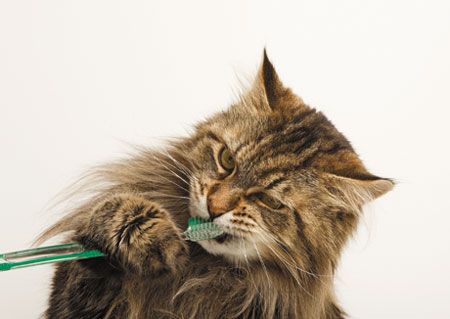3 awesome tools for veterinary dentistry
These tools and features are on every badass dental technician's wish list. Spend now, save time (and teeth!) later. Plus, bonus tips on ... toothbrushes and scaler tips!

Come on, cat. Before we get to how cool a simple toothbrush is during a dental cleaning, you'll want to hear about the cool technology ... (Getty Images)1. Ultrasonic hand scalers with fiber optic lights
"A lot of the new ultrasonic hand scalers have a fiber optic light attached," says Mary Berg, BS, RVT, RLATG, VTS (dentistry), owner of Beyond the Crown Veterinary Education. "It makes visualization of the oral cavity so much better. It's not enough to be blinding, so you can identify tissue colors and really see tartar. How did I live without this? I know Summit Hill has one on their scaler."
Pick a pack of pristine dental picks
Hey, you. Yes, you. Mary Berg thinks you'd be a happier dental tech if you'd just:
> Use the correct tip on the scaler. "Most people just use one tip, the universal tip," Berg says. "It's designed to go above the gum line and go into pockets below the gum line, but the problem is, it's not very effective." See, it's too small to do the gross cleaning on the crowns, and it's too large to get into the periodontal pockets. "Take two seconds to change the tip. You're gonna be so much faster."
> Change out your old tips. "A dental scaler usually comes with a guide," Berg says. "Lay the tips on the guide and see how many millimeters are gone from use." Spend a few bucks and change your tips: "You don't buy one and you're done," she says. Trust Berg-you'll be faster and better.
Want bonus points? Benita Altier, LVT, VTS (dentistry), owner of Pawsitive Dental Education, loves swivel connectors. "I want them on the handpieces themselves so that they turn when I need to angle the handpiece to the patient," she says.
2. Magnification loupes
"I can't imagine doing a dental procedure on small dog or cat teeth without one," says Berg. "I have a pair from Miltex with a head lamp and everything. The 18-in focal distance and angle also forces you to be more ergonomically correct, so it can help with back pain and make sure you're sitting up straight."
3. Easy-to-read dental probes
It's the death knell for a perfectly good dental probe: You have trouble reading the millimeter markings. For goodness sake, just get a new one!
The 'simplest, cheapest, most underused tool in the oral cavity'
Berg says it's a soft-bristle toothbrush: "Once you've charted the mouth and you've done the oral exam, thoroughly brush the teeth. Then take your air/water syringe and power-wash off the debris. You'll get, like, 80 percent of the plaque brushed off before you get to scaling."
"I have a 15-mm probe from Miltex [Editor's note: Here's one like it], where every millimeter has a demarcation with a little bit of an indentation," Berg says. "It's very easy to read. And every fifth millimeter is darker, so it's easy to see whether you're at five or 10 or 15."
Find a good one that keeps its colors, or replace your favorite more often. And invest a few bucks in a few extras: "Somebody's going to drop one, and if you have multiple patients, you don't want to share a probe," she says.
And what else makes hand tools easier to use? Comfort and easy identification. Altier's a fan of soft-grip handles on Miltex periodontal instruments and the soft handles on Cislak instruments. "People love the easy-to-grip surfaces and the bright colors to help identify instruments as you pick them up to use them," she says.